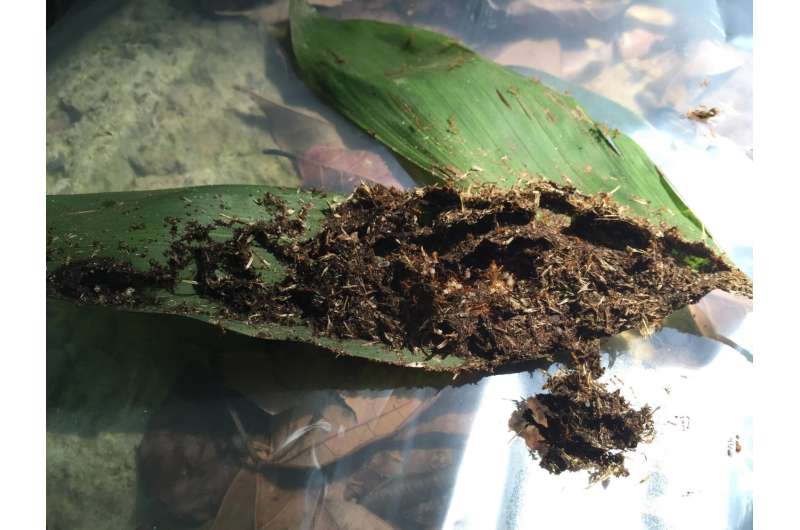One of the observed ant nests was located on the underside of a palm leaf. Credit: John Hash
While many species of scuttle flies are associated with ants, their specific interactions with their hosts are largely unknown. Brood parasitism (attacking the immature stages, rather than the adult ants), for example, is an extremely rarely observed and little-studied phenomenon. However, a research team from the USA and Brazil, led by Dr. Brian Brown, Natural History Museum of Los Angeles County, have recently video-documented two such occasions. The observations are published in the open access Biodiversity Data Journal.
One of the videos, taken in Brazil, shows female scuttle flies attacking ants evacuating their nest. Having had their colony exposed, worker ants try to carry the brood to the nearest shelter. The flies follow these workers on foot, and bump into them in attempt to make them drop the larvae. The scientists have provided a video of an ant which, when harassed, left a larva in a partially exposed position and fled. Immediately, the fly attacked the larva, laying an egg inside its body. The fact that the flies attack the relatively soft-bodied larvae explains the puzzling structure of the ovipositor (egg-layer) of this species (Ceratoconus setipennis), which appears much less hardened than the ovipositor of species attacking adult ants. As a result of the present observation, however, their association with ants is no longer a mystery.
The second footage, filmed in Costa Rica, shows an undescribed species of scuttle fly (genus Apocephalus) that fly above the ants. When they spot a worker carrying brood, it would plunge down to it, approach the ant from behind and land on the (in this case) pupa. Then, it flips over onto its back, keeping the pupa between itself and the ant, while it lays an egg into the pupa from an upside-down position.
"The video documentation of two very different types of brood parasitism of ant species by scuttle flies was recorded in two countries within just a few months of one another," conclude the authors. "This hints at the many remarkable behaviors of phorid flies that may still await discovery by the patient observer. It appears brood parasitism may not be as rare as was once assumed, and that there may be a tremendous amount of information to uncover about these behaviors."
More information: Brian Brown et al, Baby Killers: Documentation and Evolution of Scuttle Fly (Diptera: Phoridae) Parasitism of Ant (Hymenoptera: Formicidae) Brood, Biodiversity Data Journal (2017). DOI: 10.3897/BDJ.5.e11277
Provided by Pensoft Publishers























